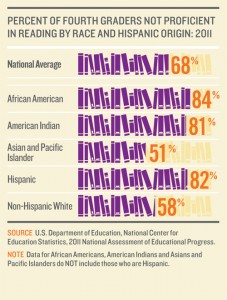U.S. Educational Outcomes Improved Despite Our Economic Woes
Headlines about the “crisis in education” might lead you to believe otherwise but most educational outcomes in the United States have improved over the last decade. High school graduation rates and national math and reading scores for students of all races and incomes are higher than ever. More kids stay in school and go to college than ever and this trend persisted despite the latest recession.
But, all is far from perfect. Where you live makes a profound difference on the quality of public school options available. Deep disparities in educational achievement by race and particularly by income persist. A recent Stanford study found that the gap in standardized test scores between affluent and low-income students has grown by about 40 percent since the 1960s. Key educational outcomes for African American, Latino and American Indian children still lag other children nationally.
To ensure that our future workforce can compete on a global scale, we must address educational disparities. Most of the new jobs created over the next decade will require not only a high school diploma but also some postsecondary education, training or certification.
Efforts to address the achievement gap must begin long before children enter kindergarten. For example, comprehensive early childhood programs and high-quality preschool can improve school readiness among low-income children. Unfortunately, according to the Annie E. Casey Foundation’s 2012 KIDS COUNT Data Book, between 2008 and 2010, more than 4.2 million 3- and 4-year olds (or 53 percent of this age group) were not enrolled in preschool.
A troubling 68 percent of fourth graders in public school were reading below proficient level in 2011. By then, students use reading to learn other subjects. Children who reach fourth grade unable to read proficiently typically lag academically and are more likely to drop out of high school.
Just as reading proficiently by the end of third grade is a critical marker of later academic success, so too is eighth grade math proficiency. Students who take advanced math and science courses are more likely to attend and complete college. Even for young people who do not attend college, basic math skills improve employability and are associated with higher earnings. Unfortunately, most students — (66 percent) of public school eighth graders scored below proficient in math in 2011.
Addressing disparities requires smart investments that boost achievement in early grades and the continued funding of education systems despite state budget crises. To do otherwise not only jeopardizes the potential of each student, but also the nation’s future ability to compete globally.
See how your state's educational outcomes measure up in the 2012 KIDS COUNT Data Book .


The views and opinions expressed in this post are those of the author(s) and do not necessarily reflect those of MomsRising.org.
MomsRising.org strongly encourages our readers to post comments in response to blog posts. We value diversity of opinions and perspectives. Our goals for this space are to be educational, thought-provoking, and respectful. So we actively moderate comments and we reserve the right to edit or remove comments that undermine these goals. Thanks!